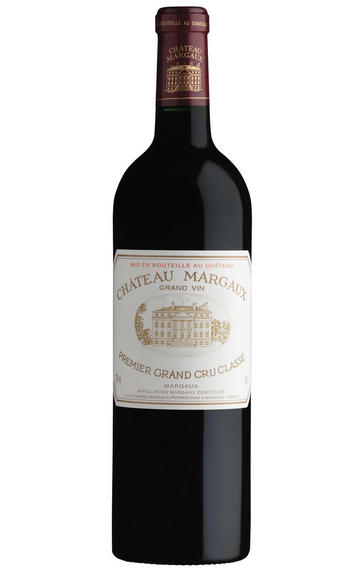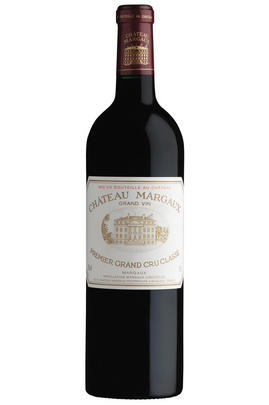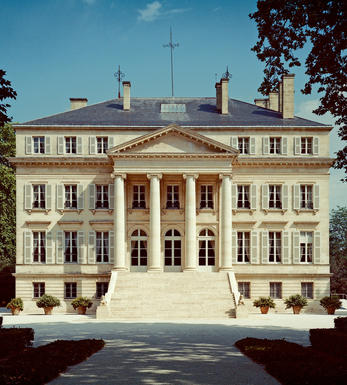
2010 Château Margaux, Margaux, Bordeaux

Critics reviews
The 2010 Château Margaux performed far better at this horizontal than at Farr's blind tasting a few days later. It has a beguiling bouquet, highly perfumed with crushed violets infusing the blackberry and crushed strawberry scented, hints of pencil box and cedar emerging with time. The palate is medium-bodied with supple tannins and a fine bead of acidity. There is a wonderful sense of symmetry here with a silky elegant finish that is amazingly persistent. It is one of the best wines that Paul Pontallier ever made.
Drink 2025 - 2060
Neal Martin, Vinous.com (April 2020)
As we head out of Pauillac, you feel the register change. It takes a heartbeat to adjust, but then you start to see the beauty of a different style of 2010, a little more elegant, a little more sculpted, with concentration that sits deep in the body of the wine but builds more slowly through the palate. This shows the beauty of the appellation of Margaux in the way that you always want and hope the First Growths will - a signpost towards the rest, showing why they should be celebrated. Here are violet aromatics, soft black truffle flavours and silky, elongated tannins. Extremely good quality; fairly savoury berry fruits. As with all of these, there's a long long life ahead of it, and best to be put away for another five years at least.
Drink 2025 - 2050
Jane Anson, Decanter.com (January 2020)
Deep garnet in colour, the 2010 Château Margaux features notions of minted blackcurrants, new leather and Black Forest cake with nuances of sautéed herbs, tar, underbrush and wild fungi plus a waft of cedar. Full-bodied, the palate has a rock-solid structure of firm, grainy tannins and bold freshness supporting the taut, muscular fruit, finishing long and earthy.
Drink 2023 - 2060
Lisa Perrotti-Brown MW, Wine Advocate (March 2020)
The 2010 Ch Margaux is amazingly dark purple. Very, very strongly Cabernet Sauvignon (90% of the blend - only 2006 matched it) with some light vegetation at first which opened out and mellowed to something utterly seductive in the glass. Dry and intense. Very rich on the front and amazingly supple – it smells as though it may be going to be a bit of brute but on the palate it is still so intense and polished initially but then it is clear that there are masses and masses of tannins. There is noble, fine, perfectly confident, minerally fruit that opens out on the palate. It is thinkable to drink this already!
Drink 2020 - 2050
Jancis Robinson MW, JancisRobinson.com (April 2011)
Superfocused and superracy, with torrents of cherry, raspberry and plum fruit. Offering terrific mouthfeel, this glides by effortlessly, with a fantastic perfume developing on the finish. Long and iron-tinged. Really, really fine-grained. Other than 2006, this is the only vintage since 2000 with as much Cabernet Sauvignon (90%).
James Molesworth, Wine Spectator (March 2011)
This was phenomenal from barrel and remains so. The aromas are spellbinding. It smells like a bouquet of pink roses and then goes to currants, berries and citrus. Full body, with wonderfully refined tannins. It starts discretely and then grows to different levels and dimensions like a slow but big high tide. The texture is so beautiful.
Try it in 2020 or beyond.
James Suckling, JamesSuckling.com (February 2013)
The 2010 is a brilliant Chateau Margaux, as one might expect in this vintage. The percentage of Cabernet Sauvignon in the final blend hit 90%, the balance Merlot and Cabernet Franc, and only 38% of the crop made it into the Chateau Margaux. Paul Pontallier, the administrator, told me that this wine has even higher levels of tannin than some other extraordinary vintages such as 2005, 2000, 1996, etc.
Deep purple, pure and intense, with floral notes, tremendous opulence and palate presence, this is a wine of considerable nobility. With loads of blueberry, black currant and violet-infused fruit and a heady alcohol level above 13.5% (although that looks modest compared to several other first growths, particularly Chateau Latour and Chateau Haut-Brion), its beautifully sweet texture, ripe tannin, abundant depth and profound finish all make for another near-perfect wine that should age effortlessly for 30-40 years.
Drink 2013 - 2053
Robert M. Parker, Jr., Wine Advocate (February 2013)
The wine is a blend of 90% Cabernet and 7% Merlot; picking began with the latter on 22 September.
Fresh and youthful aromas of understated curranty fruit with cedar, smoke, and spice accents lead to a silky, archetypical Margaux texture with silky tannins, perfect weight, balance, and impressive length. The edges of this wine - so evident en primeur - are now pleasantly rounded and supple, but there is no mistaking the power and age-ability of this triumphant vintage.
Drink 2030 - 2070
Charles Curtis, Decanter.com (July 2023)
Possibly the greatest wine this illustrious château has ever produced, and that’s saying a lot. The grand vin contains the highest-ever percentage of Cabernet Sauvignon, reflecting Paul Pontallier’s belief in the grape’s outstanding quality in 2010 and vindicating his decision to introduce a third tier red wine to allow even greater selection. An even better wine than the impressive 2009, this is very dense for a Margaux, with sweet plum, bramble and blackcurrant fruit, serious, yet silky tannins and a fine, refreshing, tapering finish.
Drink 20+ years
Tim Atkin MW, TimAtkin.com (May 2011)
Reminding me slightly of the 1996 (and maybe the 2019) with its purity and precision, the 2010 Château Margaux offers a classic bouquet of red and black currants, green tobacco, sandalwood, spring flowers, and lead pencil shavings. Rich, full-bodied, and beautifully concentrated on the palate, with ripe tannin and integrated yet notable acidity, this is as classic and regal as Margaux gets, and while it has a terrific sweetness of fruit and ripeness to its tannins, it needs another 4-5 years to hit true prime time and is going to evolve for another 30 years or more.
Drink 2026 - 2057
Jeb Dunnuck, JebDunnuck.com (March 2022)
Saturated ruby-red. Deep aromas of blackberry, liquorice and bitter chocolate, complicated by nuances of loam and coffee extract. Dense, thick and sweet, but with harmonious acidity giving shape and lift to the pungent cassis, spice and tobacco flavors. Youthfully chewy wine with terrific underlying structure and a very long, sappy finish featuring broad tannins and a hint of licorice. This has improved considerably since the Primeurs, but I still think the 2009 Margaux is the superior wine.
Stephen Tanzer, Vinous.com (July 2013)
About this WINE

Chateau Margaux
Château Margaux, a First Growth property, has been owned by the Mentzelopoulos family since 1978. It has since consistently produced some of the finest wines in the Médoc.
One of the grandest, most imposing buildings amongst the Médoc châteaux, Ch. Margaux in its current form was built in the early 19th century, although viticulture had been practised on the estate for several centuries before. A chequered period of ownership in the 19th and early 20th century meant that the quality of some vintages was patchy. But the change which restored the property to its rightful status came in 1977 when it was bought by André Mentzenopoulos, Greek by birth but who had lived in France since 1958 and had made a fortune through supermarket retailing. André immediately instigated much-needed investment in vineyard and cellar. His untimely death in 1980 saw his daughter, Corinne, take up the reins. Corinne’s shrewdest move was the recruitment of talented young winemaker Paul Pontallier to oversee the production.
Paul would lead the estate for 33 vintages. He sadly passed away in 2016. Today, the estate is overseen by director Philippe Bascaules and technical director Sebastien Vergne, working with consultant Eric Boissenot.
The estate has 82 hectares under vine, with Cabernet Sauvignon inevitably dominant (75%) with 20% Merlot making up most of the rest, along with a smattering of Cabernet Franc and Petit Verdot. Unusually in Margaux, there is a white wine made here, Pavillon Blanc, from 100% Sauvignon Blanc, while the two red wines are, of course, Ch. Margaux itself and Pavillon Rouge. Typically, about 30,000 cases of red wine are made, with the Grand Vin usually accounting for just over 40% of the total. Production of the white wine amounts to less than 3,000 cases.
Margaux wines are renowned for their perfumed elegance, but this should not be construed as meaning that these are light-bodied. Far from it, as the best have an enviable structure, layers of complexity, and formidable length.

Margaux
If Pauillac can be seen as the bastion of ‘traditional’ Red Bordeaux, then Margaux represents its other facet in producing wines that are among Bordeaux’s most sensual and alluring. It is the largest commune in the Médoc, encompassing the communes of Cantenac, Soussans, Arsac and Labaude, in addition to Margaux itself. Located in the centre of the Haut-Médoc, Margaux is the closest of the important communes to the city of Bordeaux.
The soils in Margaux are the lightest and most gravelly of the Médoc, with some also containing a high percentage of sand. Vineyards located in Cantenac and Margaux make up the core of the appelation with the best vineyard sites being located on well-drained slopes, whose lighter soils give Margaux its deft touch and silky perfumes. Further away from the water, there is a greater clay content and the wines are less dramatically perfumed.
Margaux is the most diffuse of all the Médoc appelations with a reputation for scaling the heights with irreproachable wines such as Ch. Margaux and Ch. Palmer, but also plumbing the depths, with too many other châteaux not fulfilling their potential. There has been an upward shift in recent years, but the appellation cannot yet boast the reliability of St Julien. However, the finest Margaux are exquisitely perfumed and models of refinement and subtlety which have few parallels in Bordeaux.
Recommended Châteaux: Ch. Margaux, Ch. Palmer, Ch. Brane-Cantenac, Ch. Rauzan-Ségla , Ch. Dufort-Vivens, Ch. Ferrière, Ch. du Tertre, Ch. Giscours, Ch. d'Angludet.

Cabernet Sauvignon Blend
Cabernet Sauvignon lends itself particularly well in blends with Merlot. This is actually the archetypal Bordeaux blend, though in different proportions in the sub-regions and sometimes topped up with Cabernet Franc, Malbec, and Petit Verdot.
In the Médoc and Graves the percentage of Cabernet Sauvignon in the blend can range from 95% (Mouton-Rothschild) to as low as 40%. It is particularly suited to the dry, warm, free- draining, gravel-rich soils and is responsible for the redolent cassis characteristics as well as the depth of colour, tannic structure and pronounced acidity of Médoc wines. However 100% Cabernet Sauvignon wines can be slightly hollow-tasting in the middle palate and Merlot with its generous, fleshy fruit flavours acts as a perfect foil by filling in this cavity.
In St-Emilion and Pomerol, the blends are Merlot dominated as Cabernet Sauvignon can struggle to ripen there - when it is included, it adds structure and body to the wine. Sassicaia is the most famous Bordeaux blend in Italy and has spawned many imitations, whereby the blend is now firmly established in the New World and particularly in California and Australia.


Buying options
Add to wishlist
Description
90% Cabernet Sauvignon, 7% Merlot, 1.5% Cabernet Franc, 1.5% Petit Verdot.
What a truly remarkable wine! A complex, multilayered, magnificent marvel; it really does posses true majesty. It has a real grace and power that has you fumbling for words to describe its quality with any degree of sophistication. There is layer upon layer of perfect dense red fruit wrapped around a kernel of ultra-fine, ultra-dense ripe tannins. Ch. Margaux 2000 and 2005 are some of the greatest barrel samples I have ever tried, and the 2010 is up there again, matching the incredible Ch. Latour as wine of the vintage.
Berry Bros. & Rudd
wine at a glance
Delivery and quality guarantee